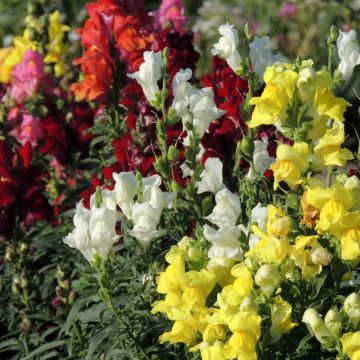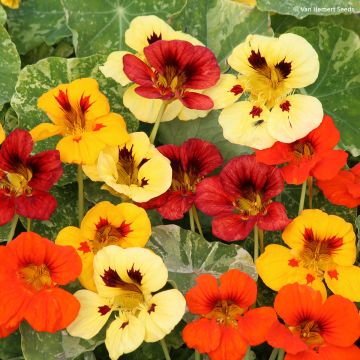

Nicotiana Suaveolens
Nicotiana suaveolens
Nicotiana suaveolens
Australian tobacco, sweet-scented tobacco
Special offer!
Receive a €20 voucher for any order over €90 (excluding delivery costs, credit notes, and plastic-free options)!
1- Add your favorite plants to your cart.
2- Once you have reached €90, confirm your order (you can even choose the delivery date!).
3- As soon as your order is shipped, you will receive an email containing your voucher code, valid for 3 months (90 days).
Your voucher is unique and can only be used once, for any order with a minimum value of €20, excluding delivery costs.
Can be combined with other current offers, non-divisible and non-refundable.
Why not try an alternative variety in stock?
View all →This plant carries a 6 months recovery warranty
More information
We guarantee the quality of our plants for a full growing cycle, and will replace at our expense any plant that fails to recover under normal climatic and planting conditions.
Would this plant suit my garden?
Set up your Plantfit profile →
Description
The Ornamental Tobacco Nicotiana suaveolens, also known as N. noctiflora, is a graceful variety of ornamental tobacco with abundant flowering of white pendulous trumpets cascading with fragrance.
Nicotiana or ornamental tobacco is a member of the Solanaceae family and originates from tropical and subtropical regions of South and Central America. Very floriferous, it blooms throughout the summer season until the first frost. Still very rare in French gardens, ornamental tobacco deserves to be known for the originality of its often highly fragrant flowers and the touch of exoticism it brings. Most tobacco species produce flowers that open in the late afternoon to diffuse their jasmine-like scent throughout the night and close with the appearance of the sun in the morning. These plants are known as vespertine. Some hybridizations now offer daytime flowering and flowers in various colours.
Nicotiana plants display their inflorescence in loose racemose clusters. The long calyx, composed of 5 fused sepals, surrounds the base of the corolla and collects tiny seeds at the end of flowering. This corolla, composed of 5 fused and elongated tubular petals, abruptly widens into five more or less notched lobes resembling a star and releases 5 long stamens. As for the leaves, they are often covered with a short glandular down that makes them sticky and tacky.
Nicotiana suaveolens is the Australian cousin of Nicotiana sylvestris as they are very similar. It blooms throughout the summer until the first frost and displays slightly purplish, loosely clustered, elongated tubular flowers. The widened part is widely notched, with each petal having two well-defined lobes. Highly branched, the plant forms bushes that reach a height of 60 to 80cm (24 to 32in) and a width of 30 to 40cm (12 to 16in).
Nicotiana plants prefer full sun or light shade in consistently moist but well-drained soil, protected from strong winds. They will be magnificent in mixed borders, mass borders, or in large pots on a patio. They are unparalleled in a scented garden accompanied by Mirabilis jalapa, Datura meteloides, Spider Flower Cleome 'Colour Fountain', or Evening Stock Matthiola bicornis, each playing its part in an olfactory symphony.
Did you know that the pollination method of Nicotiana plants is directly related to the nicotine content in their flowers? Indeed, research has shown that varieties with low nicotine levels need bees, butterflies, etc. to pollinate them. The fragrance of the flowers is intended to attract them. However, varieties with very high nicotine levels can be lethal to insects. They have found a solution by self-pollinating. How else could they proceed if the pollinator's work is compromised?
Attention, seeds reserved for highly experienced gardeners who are used to sowing very fine seeds. These seeds are as fine as dust, barely visible to the naked eye.
Flowering
Foliage
Plant habit
Botanical data
Nicotiana
suaveolens
Solanaceae
Australian tobacco, sweet-scented tobacco
Australia
Other Tobacco seeds
View all →Planting and care
Sow the seeds from February to March on the surface of a specific research area compost. Nicotiana seeds are tiny. You can mix them with a bit of sand to distribute them more evenly. Firmly press them down but do not bury them. Make sure the substrate is always moist without excess and keep them in a place where the room temperature is around 21 to 24°C (69.8 to 75.2°F). Do not exclude light, as it is necessary for germination. You will then see the first young shoots appear after 10 to 20 days. When they are strong enough to handle, gradually acclimate them to outdoor conditions. And when all risk of frost is eliminated and daytime temperatures are above 16°C (60.8°F), you can transplant them into well-prepared and well-drained soil.
Position them in full sun or light shade in soil that is always moist but not waterlogged, sheltered from the wind, and be sure to space them 40cm (16in) apart.
Sowing period
Intended location
Planting & care advice
This item has not been reviewed yet - be the first to leave a review about it.
Similar products
Haven't found what you were looking for?
Hardiness is the lowest winter temperature a plant can endure without suffering serious damage or even dying. However, hardiness is affected by location (a sheltered area, such as a patio), protection (winter cover) and soil type (hardiness is improved by well-drained soil).

Photo Sharing Terms & Conditions
In order to encourage gardeners to interact and share their experiences, Promesse de fleurs offers various media enabling content to be uploaded onto its Site - in particular via the ‘Photo sharing’ module.
The User agrees to refrain from:
- Posting any content that is illegal, prejudicial, insulting, racist, inciteful to hatred, revisionist, contrary to public decency, that infringes on privacy or on the privacy rights of third parties, in particular the publicity rights of persons and goods, intellectual property rights, or the right to privacy.
- Submitting content on behalf of a third party;
- Impersonate the identity of a third party and/or publish any personal information about a third party;
In general, the User undertakes to refrain from any unethical behaviour.
All Content (in particular text, comments, files, images, photos, videos, creative works, etc.), which may be subject to property or intellectual property rights, image or other private rights, shall remain the property of the User, subject to the limited rights granted by the terms of the licence granted by Promesse de fleurs as stated below. Users are at liberty to publish or not to publish such Content on the Site, notably via the ‘Photo Sharing’ facility, and accept that this Content shall be made public and freely accessible, notably on the Internet.
Users further acknowledge, undertake to have ,and guarantee that they hold all necessary rights and permissions to publish such material on the Site, in particular with regard to the legislation in force pertaining to any privacy, property, intellectual property, image, or contractual rights, or rights of any other nature. By publishing such Content on the Site, Users acknowledge accepting full liability as publishers of the Content within the meaning of the law, and grant Promesse de fleurs, free of charge, an inclusive, worldwide licence for the said Content for the entire duration of its publication, including all reproduction, representation, up/downloading, displaying, performing, transmission, and storage rights.
Users also grant permission for their name to be linked to the Content and accept that this link may not always be made available.
By engaging in posting material, Users consent to their Content becoming automatically accessible on the Internet, in particular on other sites and/or blogs and/or web pages of the Promesse de fleurs site, including in particular social pages and the Promesse de fleurs catalogue.
Users may secure the removal of entrusted content free of charge by issuing a simple request via our contact form.
The flowering period indicated on our website applies to countries and regions located in USDA zone 8 (France, the United Kingdom, Ireland, the Netherlands, etc.)
It will vary according to where you live:
- In zones 9 to 10 (Italy, Spain, Greece, etc.), flowering will occur about 2 to 4 weeks earlier.
- In zones 6 to 7 (Germany, Poland, Slovenia, and lower mountainous regions), flowering will be delayed by 2 to 3 weeks.
- In zone 5 (Central Europe, Scandinavia), blooming will be delayed by 3 to 5 weeks.
In temperate climates, pruning of spring-flowering shrubs (forsythia, spireas, etc.) should be done just after flowering.
Pruning of summer-flowering shrubs (Indian Lilac, Perovskia, etc.) can be done in winter or spring.
In cold regions as well as with frost-sensitive plants, avoid pruning too early when severe frosts may still occur.
The planting period indicated on our website applies to countries and regions located in USDA zone 8 (France, United Kingdom, Ireland, Netherlands).
It will vary according to where you live:
- In Mediterranean zones (Marseille, Madrid, Milan, etc.), autumn and winter are the best planting periods.
- In continental zones (Strasbourg, Munich, Vienna, etc.), delay planting by 2 to 3 weeks in spring and bring it forward by 2 to 4 weeks in autumn.
- In mountainous regions (the Alps, Pyrenees, Carpathians, etc.), it is best to plant in late spring (May-June) or late summer (August-September).
The harvesting period indicated on our website applies to countries and regions in USDA zone 8 (France, England, Ireland, the Netherlands).
In colder areas (Scandinavia, Poland, Austria...) fruit and vegetable harvests are likely to be delayed by 3-4 weeks.
In warmer areas (Italy, Spain, Greece, etc.), harvesting will probably take place earlier, depending on weather conditions.
The sowing periods indicated on our website apply to countries and regions within USDA Zone 8 (France, UK, Ireland, Netherlands).
In colder areas (Scandinavia, Poland, Austria...), delay any outdoor sowing by 3-4 weeks, or sow under glass.
In warmer climes (Italy, Spain, Greece, etc.), bring outdoor sowing forward by a few weeks.





























































